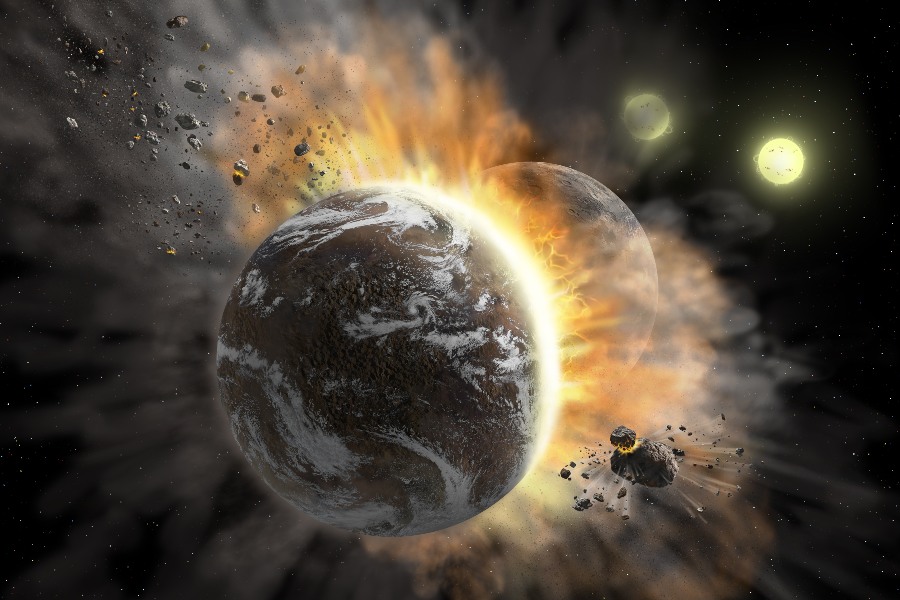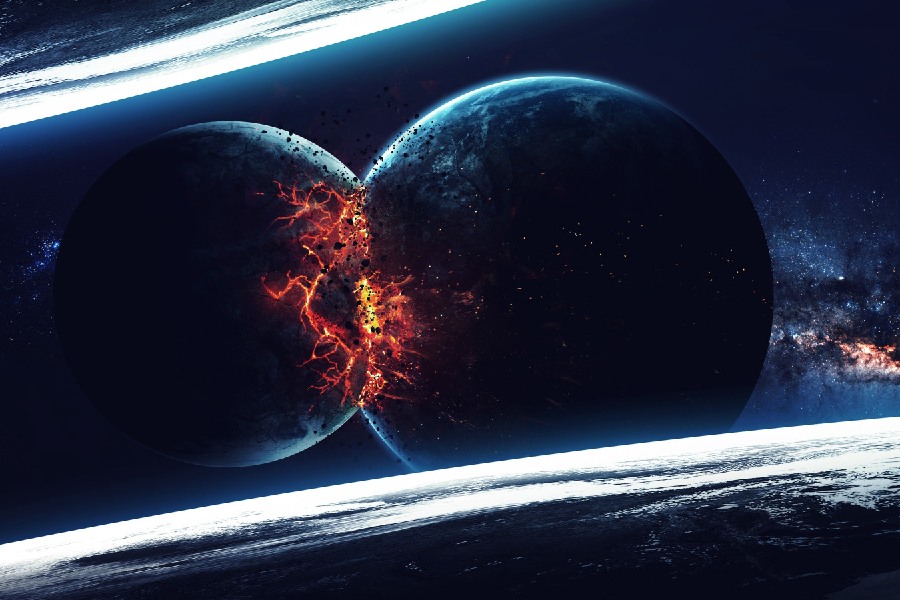From the tranquil dance of planets orbiting a star, science fiction has painted scenarios of celestial collisions. But are these crashes mere fantasy or a potential reality? Can planets collide?
In this article, we will study the forces that govern the intricate orbital dynamics that keep the world spinning safely through space. We will dive into the possibilities of collisions occurring between celestial bodies, whether between planets and the Sun, planets smashing into one another, or satellites crashing into their parent planets.
Does the orbital dance of planets actually allow room for cosmic mishaps? We will explore the gravitational forces that permit orderly motion versus catastrophic impacts. Depending on their mass, velocity, and other properties, wayward worlds do sometimes meet in disastrous crashes.
Surprisingly, collisions can also foster creation. Planetary rubble clumping together over eons can form new planetoids. Read on to uncover the fascinating world of planetary collisions, exploring how they occur, what causes them, and the potential outcomes, from fiery destruction to the birth of new celestial bodies.
Can Planets Collide?
Can planets collide? Yes, planets can collide, but it’s extremely rare. In the vastness of space, planets orbiting stars usually follow stable paths without crashing into each other. However, collisions can occur under certain circumstances. These include when two planets’ orbits are disturbed by gravitational forces.
Another scenario is if a planet is knocked out of its orbit by a large asteroid or comet. When planets do collide, it can have significant consequences, such as altering their orbits, forming new celestial bodies, or causing widespread destruction.

Reasons for Planetary Collisions
Gravitational forces and orbital mechanics
Planets collide when gravitational forces are disrupted. Gravity governs objects’ motions in space. It keeps planets in regular orbits around stars. Changes to orbits can bring planets in crossover courses. Gravitational tugging from other bodies can alter orbits over time.
Major disturbances lead worlds to fatally intersect. Collisions require precise orbital timing. But they become probable over cosmic timelines of millions to billions of years. Given enough disturbances, disaster strikes on celestial period scales.
Impacts from other objects
Collisions are not limited to planets alone. Smaller celestial bodies like meteoroids, comets, and asteroids can also impact planets, potentially altering their trajectories or even triggering volcanic activity upon impact.
Such energetic cosmic accidents redistribute momentum. Worlds recoil onto shifted orbital roads; future collisions become possible with other planets also on changing paths.
These frequent smaller collisions, alongside the rarer planetary collisions, have played a significant role in shaping the evolution of our solar system and continue to do so across the cosmos. Surprisingly, collisions can also foster creation, and this gives us an insight into what happens when planets collide. Planetary rubble clumping together over eons can form new planetoids.
Collision Scenarios and Consequences
Planetary collisions occur when orbital mechanics fail over cosmic time. Gravity normally keeps worlds in regular orbits, but disturbances can shift trajectories to intersect. For example, Mars may have grown after an early collision with a protoplanet – debris ejected likely formed the Moon.
Such accidents carry the momentum that sends worlds on changed courses toward future disasters. Will planets ever collide? Given billions of years, eventually, factors line up for a catastrophic meeting between celestial bodies flung by gravity into a shared crash site.
The results alter atmospheres, crater surfaces, and potentially drive mass extinction events on planets like Earth not massive enough to endure intact. Eons allow orbital fluctuations that lead to the occasional disastrous collisions between planets.

Planetary Collisions and Cosmic Evolution
Planetary collisions foster new worlds
Collisions generate leftover fragments that coalesce into new bodies. Nearby terrestrial debris clumps together through gravity after disasters. For example, theories propose Earth’s Moon formed from ejecta after Mars-sized protoplanets crashed into early molten Earth.
Lunar rocks support origins from fused collision rubble. Accumulated debris incrementally cements together under its own weak gravity. Over millions of years, entirely novel planetoids emerge from collision remains floating nearby in space.
Toppling dominoes of evolving systems
The sudden momentum shifts from crashes send ripples through whole systems destined to meet again. When one orbital path changes, many others ultimately follow. Worlds nudge each other like oscillating dominoes.
The directions and frequencies slowly transform until new collisions transpire. It is like celestial billiards on billion-year scales. Our solar system exhibits lingering scars from such accidents – craters record deeply buried histories hinting at the shocking disasters worlds can inflict upon their neighbors.
Understanding creation’s violence and renewal
A planet is billions of fused rocks – no planet emerges gently into existence. Creation stories across cultures speak to this violence. The cosmos builds itself through destruction and recombination endlessly.
By examining echoes of long-ago disasters, planetary collisions reveal insights into past cataclysms.
These collisions demonstrate that behind the illusion of tranquil night skies lies chaotic energies on inhuman time scales. These events unfold with startling probability, offering a glimpse into the dynamic nature of our universe.
Planetary collisions represent pivotal formative moments in our universe’s history that continue influencing Solar System evolution today. Worlds perish in violence but fuse together again from the aftermath over eons-long cycles of destruction and renewal.
Have planets ever collided? While we haven’t directly witnessed any such events, observations of other star systems hint at prior collisions between planets. A study of exoplanets sheds more light on these historical events.
Exoplanetary Collisions
Exoplanet collisions – Unique evidence
Thousands of exoplanets have been discovered orbiting distant stars. Many exoplanetary systems have very different architectures than our solar system. Exoplanets exhibit great diversity in sizes, orbits, and compositions. This suggests dynamic formation histories involving frequent collisions.
For example, hot Jupiters are gas giants orbiting extremely close to stars. They likely migrated inward after gravitational collisions pushed them into new trajectories. Chemical fingerprints show hints of past crashes. Debris from exoplanetary collisions creates distinct chemical abundance patterns in atmospheres.
For instance, added amounts of carbon predict large impacts occur. Elements like oxygen and magnesium also show disruption signatures from melted worlds. In addition, tilted axes and swirling orbital motions point to worlds that have gravitationally ricocheted off one another in the past.
Implications for exoplanet evolution
Frequent collisions contribute to exoplanet diversity over billions of years. Impacts blast away atmospheres and even break apart small exoplanets. After disasters, rubble remnants clump into new rocky bodies.
Repeated crashes make exoplanet systems much more dynamic than envisioned decades ago. Worlds mutate through ongoing collisions – orbiting nearer or farther from stars, changing chemical makeups. Planetary evolution never stands still with gravitational forces constantly nudging fate.
Conclusion
The complex orbital dance of planets does sometimes lead to cataclysmic crashes. Gravity, velocity, and other factors allow cosmic billiard balls to fatally meet. But while destructive, we’ve uncovered how collisions also seed new beginnings – coalescing rocks and dust into protoplanets.
We hope this article has helped you find out how can planets collide, either shattering worlds or ultimately forging new ones from the remnants. By grasping the gravitational forces governing celestial motions, we better understand how these epic disasters and fresh starts unfold across eons.
Planetary systems strike a balance between stability and chaos, order and randomness – collisions represent rare but dramatic demonstrations of the forces that shape galaxies.
